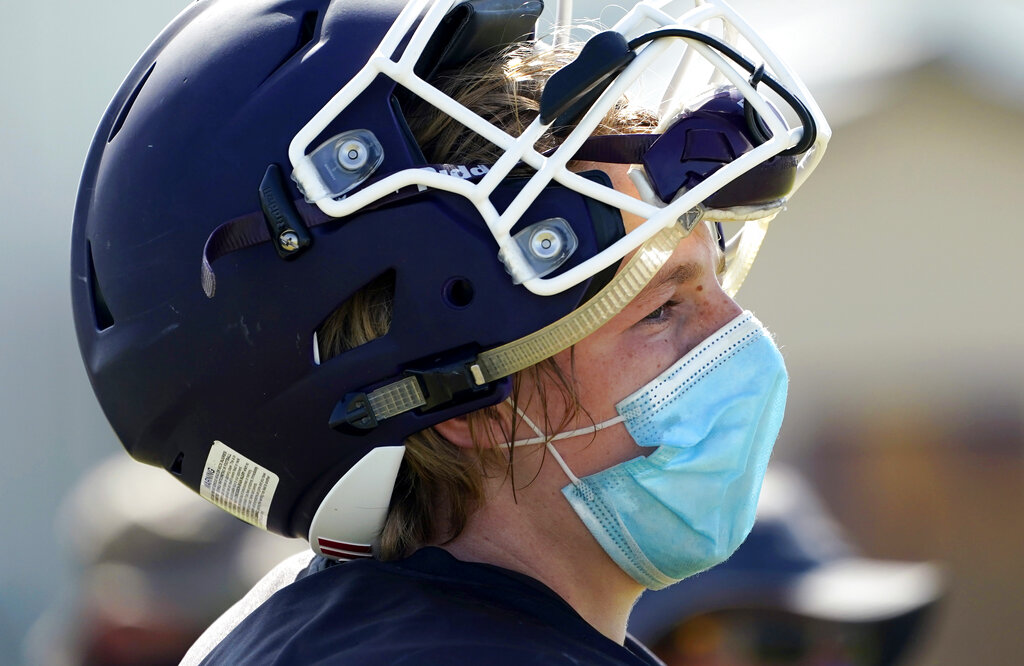States wrestle with playing high school football amid COVID-19 pandemic

THRALL, Texas (AP) — As heat waves rose from the crackling grass next to a cotton field that stretched far into the distance, Rick Porter watched his young football players struggle through a preseason practice.
Under every helmet was a masked player, breathing deep amid the dust and stifling heat topping 100 degrees fahrenheit (38 degrees celsius). August in Texas can be cruel and the coronavirus pandemic has thrown a new set of obstacles in the way.
“Social distancing!” Porter yelled as the players headed for a water break. Nearby were hand-washing stations the coach built himself by drilling holes in long pieces of PVC pipe bought at a local hardware store.
Still, Porter wonders if it will be enough to stave off an outbreak and whether his farming community 40 miles outside Austin will see football on Friday nights.
“I just hope,” Porters says with a sigh through his own cotton mask, “that we still get to play.”
Just like big-time college football, American high school sports is starkly divided on whether to play this fall.
While the national COVID-19 death toll has passed 160,000 and total infections rise above 5 million, more than a dozen states and the District of Columbia have suspended football and other sports at least until spring. Their ranks include California, Oregon, Washington, Colorado, Maryland and Illinois.
But Texas and dozens of other states are pressing on amid questions about safety and COVID-19’s long-term health impact on young athletes.
Many teams are already practicing. Utah played its first games this week; at one of them, Davis High coach Mitch Arquette told his players to seize the moment before a 24-20 win over Herriman.
“It really is the mantra of 2020: Win the day,” Arquette told the Deseret News. “You don’t know when you’re going to get another. We really don’t. We could have our game canceled next week.”
Other states are making plans to start the season.
Florida gave its high schools the OK Friday to begin later this month. Football-crazy Ohio was waiting for the go-ahead from Gov. Mike DeWine, who has hinted schools will be allowed to play a shortened season. One top recruit has already decided he won’t: Defensive end Jack Sawyer tweeted that he won”t play and will wait to join Ohio State in the spring.
Texas, which has by far the most high school football players in the nation with about 170,000, will play despite a COVID-19 death toll approaching 10,000 and health experts predicting a rise in new cases as schools open their classroms. The Lone Star State will stagger its season with small schools kicking off in late August and the big schools in late September.
Recent decisions by the Big Ten and the Pac-12 to call off fall sports raise a new dilemma for high schools. If two college conferences, with some of the nation’s most prestigious universities and medical expertise, were willing to abandon sports then should high schools be playing?
“That’s a good question. I don’t think anybody has the right answer,” said Dr. Susannah Briskin, associate professor of pediatric sports medicine at Rainbow Babies and Children’s hospital in Cleveland.
“We certainly know the majority of kids don’t develop any severe symptoms from COVID, but they absolutely can. They’re susceptible to a more significant disease course, but at this juncture it’s less often than the older population,” said Briskin, who also serves on the American Academy of Pediatrics Council on Sports Medicine and Fitness.
The AAP recommends that any high school athlete who shows symptoms of COVID-19 sit out for two to four weeks and not return until they see a doctor. The group discourages testing unless an athlete is symptomatic or has been exposed to someone who is sick.
At the college level, schools can throw massive resources at both testing and follow-up care for athletes. The Big 12 Conference will require players to be tested three times per week and anyone who tests positive must clear rigorous heart exams, including echocardiograms, a cardiac MRI, blood tests and other tests before they are cleared to return.
Briskin doesn’t see any high schools likely to match that sort of concentrated testing and medical care. High school officials across the country have generally not required testing because of cost and availability, and timely access to a cardiologist can be a problem in both rural and urban areas.
“At the high school level, the onus falls on the athlete’s family to be sure the kids are taken care of,” Briskin said.
Texas will require any athlete diagnosed with COVID-19 to be cleared by a doctor to return to play. Officials for the University Interscholastic League, the governing body for Texas public high school sports, declined to comment on the Big 12’s testing requirements and said no further rules changes were planned.
Still, Porter wondered if stricter standards will be coming eventually in Texas or elsewhere, hurdles he says would be impossibly high for small schools like his to clear.
“If they just came out in high school and said y’all need to test every kid once a week, you would probably lose every (small) school program,” said Porter, who is also the Thrall athletic director.
He noted that athletes at the University of Texas not far away will be “well taken care of.”
“Can we even get a test back in time, in a 7-day or 14-day turnaround?” he asked. “If you can pick any one of the things (colleges) are doing, I think it would shut down almost all of the highs schools in the state of Texas.”
